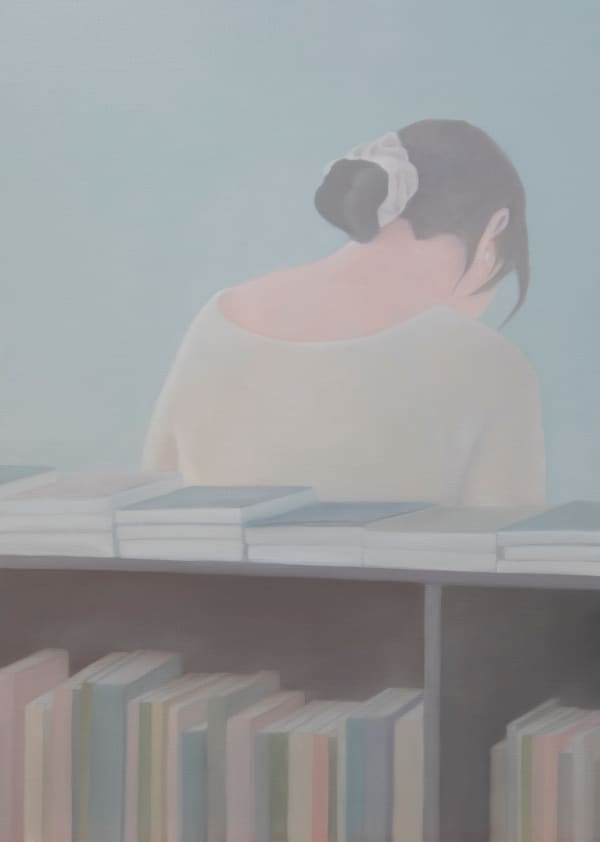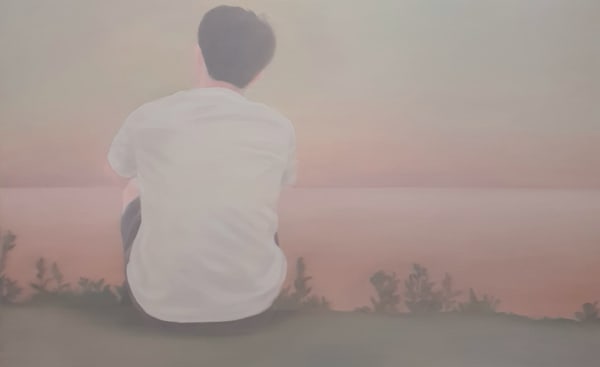-
Han Ji Min
Time Alone
-
JD Malat Gallery is pleased to present Time Alone, the debut London solo exhibition by South Korean artist Han Ji Min (b. 1978, Jeollabuk-do), opening this May in the heart of Mayfair. Featuring 17 poignant oil compositions, this exhibition marks a major milestone in Han’s career, introducing London audiences to her quiet and contemplative world.
-
 Han Ji Min in her Studio
Han Ji Min in her StudioHan Ji Min (b. 1978 Jeollabuk-do)
Han Ji Min is a contemporary artist based in Seoul, Korea recognised for her distinctly soft-edged compositions of figures in serene and peaceful environments. Han's oil paintings quietly navigate the cultural terrain of contemporary Seoul and question how we locate notions of identity and human sentiment within the human body and its surroundings. -
 Han Ji Min, Black Glasses, 2025, Oil on canvas, 17 3/4 x 17 3/4 in, 45 x 45 cm
Han Ji Min, Black Glasses, 2025, Oil on canvas, 17 3/4 x 17 3/4 in, 45 x 45 cm -
 Han Ji Min, Boy Reading a Book, 2025, Oil on canvas, 35 3/4 x 28 5/8 in, 90.9 x 72.7 cm
Han Ji Min, Boy Reading a Book, 2025, Oil on canvas, 35 3/4 x 28 5/8 in, 90.9 x 72.7 cm -
 Han Ji Min, In the Sea, 2025, Oil on canvas, 38 1/4 x 51 1/4 in, 97 x 130.3 cm
Han Ji Min, In the Sea, 2025, Oil on canvas, 38 1/4 x 51 1/4 in, 97 x 130.3 cmTime Alone
Each canvas becomes a mirror: not just of others, but of ourselves. Han draws attention to the small, subconscious gestures of daily life, inviting us to reconsider the boundaries between observer and observed. Her visual language reflects both personal experience and a keen sensitivity to contemporary life in Seoul, evoking the ambivalence of solitude, the poignancy of stillness, and the quiet hope of human connection. Time Alone, exhibited on the ground floor of JD Malat Gallery, offers a rare London glimpse into Han Ji Min’s introspective visual language, a counterpoint to the city's noise and relentless movement. It is an invitation to slow down, look closely, and reconnect with the quiet beauty of the everyday.
-
 Han Ji Min, In the Sea, 2025, Oil on canvas, 38 1/4 x 51 1/4 in, 97 x 130.3 cm
Han Ji Min, In the Sea, 2025, Oil on canvas, 38 1/4 x 51 1/4 in, 97 x 130.3 cm -
-
 Han Ji Min, Reader, 2025
Han Ji Min, Reader, 2025 -
 Han Ji Min, Egress, 2025
Han Ji Min, Egress, 2025 -
 Han Ji Min, Boy Reading a Book, 2025
Han Ji Min, Boy Reading a Book, 2025 -
 Han Ji Min, A Memory, 2025
Han Ji Min, A Memory, 2025 -
 Han Ji Min, A Writer, 2025
Han Ji Min, A Writer, 2025 -
 Han Ji Min, Black Glasses, 2025
Han Ji Min, Black Glasses, 2025 -
 Han Ji Min, The Woman Who Makes Books, 2025
Han Ji Min, The Woman Who Makes Books, 2025 -
 Han Ji Min, Blurry Memory, 2025 Sold
Han Ji Min, Blurry Memory, 2025 Sold -
 Han Ji Min, The Person Who Turned his Back, 2025
Han Ji Min, The Person Who Turned his Back, 2025 -
 Han Ji Min, In the Sea, 2025 Sold
Han Ji Min, In the Sea, 2025 Sold -
 Han Ji Min, On the table , 2025
Han Ji Min, On the table , 2025 -
 Han Ji Min, One Person, 2025 Sold
Han Ji Min, One Person, 2025 Sold -
 Han Ji Min, Record of the Night, 2025 Sold
Han Ji Min, Record of the Night, 2025 Sold -
 Han Ji Min, Snow-Covered Bookstore, 2025 Sold
Han Ji Min, Snow-Covered Bookstore, 2025 Sold -
 Han Ji Min, What I Left Behind, 2025
Han Ji Min, What I Left Behind, 2025 -
 Han Ji Min, Woman with Hat , 2025
Han Ji Min, Woman with Hat , 2025 -
 Han Ji Min, Your Studio, 2025 Sold
Han Ji Min, Your Studio, 2025 Sold
-
Han Ji Min | Time Alone : London
Past viewing_room





















